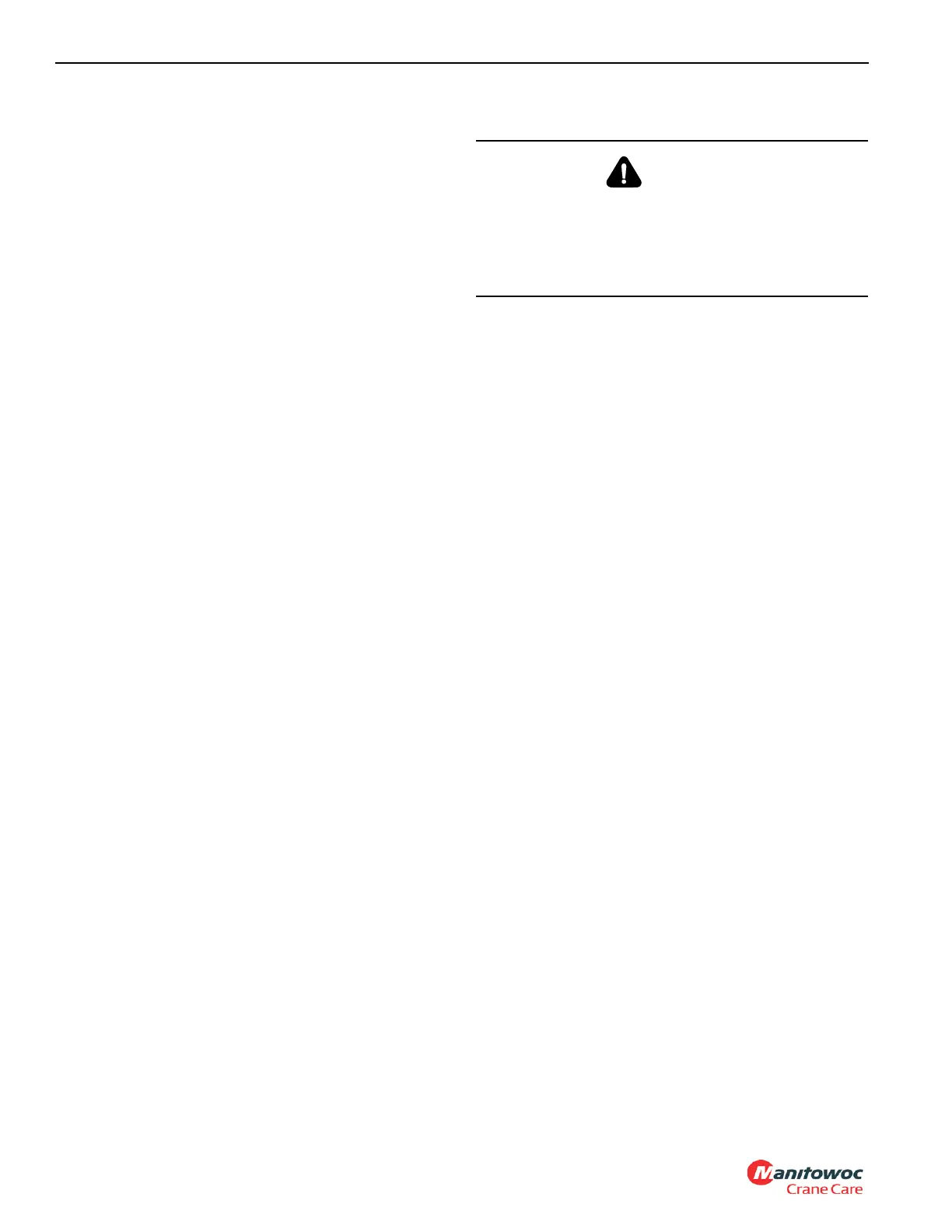POWER TRAIN RT770E
7-18
Published 11/26/2014, Control # 447-05
surge tank filler neck. Fill slowly. Flow exceeding 3 gpm
(11.2 L/min) can give a false reading.
2. Wait one minute and recheck the antifreeze/coolant
level. Refill as necessary repeating step 1.
3. Run the engine for 5 minutes and recheck the
antifreeze/coolant level. Refill as necessary repeating
step 1. Refer to Lubrication, page 9-1.
Antifreeze/Supplemental Coolant Additives
Maintenance Summary
Cooling System Level Check Interval
Daily or 10 hours
The cooling system level should be checked every 10 hours
of operation or daily, whichever comes first. Refer to
Lubrication, page 9-1.
SCA Level Check Interval
6 months or 500 hours
• Check SCA Levels (use only Coolant Test Kit, Grove
part number 9414101675, to check the coolant additive
concentration in the cooling system).
Only add coolant additive if levels are less than 1.2 units/
gal (see : Standard Lubricants [Down to -9°C (15°F)],
page 9-2 for specification and recommended additives).
NOTE: An inadequate concentration of coolant additive
can result in major corrosive damage to the cooling
system components. Over concentration can
cause formation of a “gel” that can cause restriction
or plugging of coolant passages, and overheating.
1 year or 1000 hours
• Test antifreeze/coolant for contamination.
Condemning limits are:
- Sulfate level greater than or equal to 1500 ppm.
- Chloride level greater than or equal to 200 ppm.
- The ph level is less than 6.5
- Oil or fuel contamination can be identified by odor or
color.
If condemned, flush the system using a commercially
available flushing agent. Refill system with fully
formulated extended life coolant. Refer to Lubrication,
page 9-1.
NOTE: Remove the radiator cap when draining the system
to ensure proper draining.
Cleaning
1. Coolant shut-off valves to heaters and other accessories
should be open to allow complete circulation during
cleaning, flushing, and draining. Run the engine with
radiator covered if necessary until temperature is up to
operating range 71 to 82°C (160 to 180°F). Stop the
engine, remove the radiator cap, and drain the system
by opening the drain cocks on the radiator and engine
block.
NOTE: Use a cleaning compound that is not corrosive to
aluminum to prevent damage to the radiator.
2. Allow the engine to cool, close the drain cocks, and pour
the cleaning compound into the surge tank according to
the directions. Fill the system with water.
3. Place a clean drain pan to catch the overflow, and use it
to maintain the level in the radiator. Do not spill the
solution on the vehicle paint.
4. Replace the radiator cap and run the engine at moderate
speed, covering the radiator if necessary, so the system
reaches a temperature of 82°C (180°F) or above, but
does not reach the boiling point. Allow the engine to run
at least two hours, or according to recommendations of
the manufacturer of the cleaning compound, at 82°C
(180°F) so the cleaning solution may take effect. Do not
drive the vehicle or allow the liquid level in the radiator to
drop low enough to reduce circulation.
5. Stop the engine as often as necessary to prevent boiling.
6. With the engine stopped, feel the radiator core with bare
hands to check for cold spots, and then observe the
temperature gauge reading. When there is no change in
temperature for some time, drain the cleaning solution.
7. If clogging of the core is relieved but not fully corrected,
allow the engine to cool, pressure-flush the system (see
Pressure Flushing) and repeat the cleaning operation.
8. If problem persists, replace radiator.
Pressure Flushing
1. Disconnect both radiator hoses that connect the radiator
to the engine.
2. Clamp a convenient length of hose to the radiator core
outlet opening, and attach another suitable length of
CAUTION
Burn Hazard!
The cooling system contains very hot pressurized liquid
and injury can result when removing the radiator cap at
operating temperature. Use proper protection to remove
the radiator cap.
